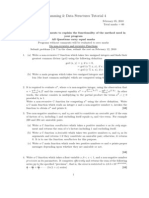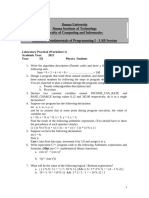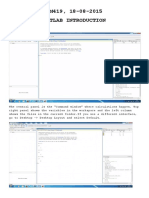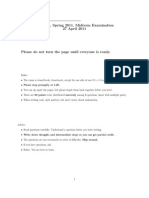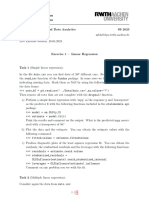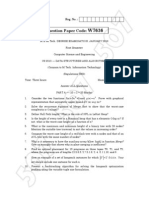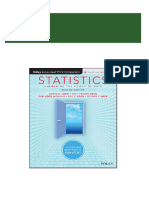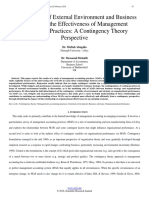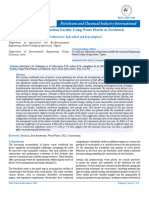0 ratings0% found this document useful (0 votes)
8 viewsWorksheet 2
Worksheet 2
Uploaded by
icelon NThis document provides instructions for a computer experiments and uncertainty quantification worksheet involving a regression model. Students are asked to:
1. Generate data from the given model and plot the results.
2. Fit a polynomial regression to the data and analyze the model fit.
3. Assess the prediction error of the polynomial regression model using different degrees of polynomials on a test dataset.
Copyright:
© All Rights Reserved
Available Formats
Download as PDF, TXT or read online from Scribd
Worksheet 2
Worksheet 2
Uploaded by
icelon N0 ratings0% found this document useful (0 votes)
8 views2 pagesThis document provides instructions for a computer experiments and uncertainty quantification worksheet involving a regression model. Students are asked to:
1. Generate data from the given model and plot the results.
2. Fit a polynomial regression to the data and analyze the model fit.
3. Assess the prediction error of the polynomial regression model using different degrees of polynomials on a test dataset.
Original Title
Worksheet2
Copyright
© © All Rights Reserved
Available Formats
PDF, TXT or read online from Scribd
Share this document
Did you find this document useful?
Is this content inappropriate?
This document provides instructions for a computer experiments and uncertainty quantification worksheet involving a regression model. Students are asked to:
1. Generate data from the given model and plot the results.
2. Fit a polynomial regression to the data and analyze the model fit.
3. Assess the prediction error of the polynomial regression model using different degrees of polynomials on a test dataset.
Copyright:
© All Rights Reserved
Available Formats
Download as PDF, TXT or read online from Scribd
Download as pdf or txt
0 ratings0% found this document useful (0 votes)
8 views2 pagesWorksheet 2
Worksheet 2
Uploaded by
icelon NThis document provides instructions for a computer experiments and uncertainty quantification worksheet involving a regression model. Students are asked to:
1. Generate data from the given model and plot the results.
2. Fit a polynomial regression to the data and analyze the model fit.
3. Assess the prediction error of the polynomial regression model using different degrees of polynomials on a test dataset.
Copyright:
© All Rights Reserved
Available Formats
Download as PDF, TXT or read online from Scribd
Download as pdf or txt
You are on page 1of 2
Winter 2023 NCKU Modular Course
Computer Experiments and Uncertainty Quantification
Worksheet 2
Due: 5 pm of Jan 11 2023
Consider the following model, which is denoted by model (1):
𝑦 = 𝑓(𝑥) + 𝑒rror,
𝑓(𝑥) = 10 + 10 sin(4𝜋𝑥 0.9) 𝑒 −1.5𝑥 , (1)
𝑒rror ~ 𝑁(0, 1)
I. Generate a dataset
a. Generate 11 equally spaced points between 0 and 1 and assign
the resulting vector as a variable x_n11. Please type set.seed(2)
before you start writing your results.
b. Write a function for 𝑓(𝑥 ) and name the function by CE_function1.
c. Generate 11 random error values from normal distribution with
mean 0 and variance 1 and save it as a vector with name
error_n11.
d. Use results from a and c to generate 11 values as a vector for y
and assign the results as a variable y_n11.
e. Create a dataframe which includes two columns x_n11 and y_n11
and assign the resulting dataframe as a variable data_n11 .
II. Visualize the data
f. b. Plot y_n11 versus x_n11. Set the title as “Scatter Plot 1”. (Hint:
Check function plot in R )
III. Fit the model
g. Fit a polynomial regression model to the dataset data_n11 by
using the following code
#sample R code for question f
lm_n11 <- lm(y_n11 ~ poly(x_n11, 3), data_n11)
Hint: (1) Please check function lm and poly in R and (2) The example
fits a polynomial regression with degrees 3.
h. Try summary(lm_n11) and describe what you observed.
i. Plot the residuals (observed value – fitted value) versus x_n11?
What do you observe? Hint: the fitted values can be generated by
predict(lm_n11, data_n11)
j. Plot the residuals versus the fitted values.
k. Report the R square values and adjusted R square values of
lm_n11 in question (g) by using the following code:
summary(lm_n11)$r.squared
summary(lm_n11)$adj.r.squared
Check google and then provide your interpretation the r.squared
value and the adj.r.squared value you reported.
IV. Assess Prediction Error
l. Generate a testing dataset with 20 data points from model (1) and
write a for loop in R that can assess the prediction errors of the
polynomial regression model in (g) with degrees 1, 2, 3, 4, 5, 6.
Save the prediction errors in a list format.
Guideline for the worksheet
1. Please use R markdown to generate one pdf file as your worksheet
results and submit it to Moodle, so you can include your R code.
Note: It is not necessary to type the question in your results for the
submission.
2. Please remember to type the question number with your answer and
R code.
You might also like
- Tak Wing Chan - Social Status and Cultural Consumption (2010, Cambridge University Press) PDFDocument285 pagesTak Wing Chan - Social Status and Cultural Consumption (2010, Cambridge University Press) PDFOmar HazimNo ratings yet
- STAT 1520 NotesDocument61 pagesSTAT 1520 NotesnojnfoNo ratings yet
- Section 4 5 SolutionsDocument14 pagesSection 4 5 SolutionsMashiatUddinNo ratings yet
- Sample Exam For ML YSZ: Question 1 (Linear Regression)Document4 pagesSample Exam For ML YSZ: Question 1 (Linear Regression)Salton GerardNo ratings yet
- Sample Exam For ML YSZ Sample For Machine Lerning - CMNKNVMNCS."NMD, MN, MVN, MDNV, MNDV MC, MDN, MDCNVM, NDV, M Ccwdmnbnbew, MwbeDocument4 pagesSample Exam For ML YSZ Sample For Machine Lerning - CMNKNVMNCS."NMD, MN, MVN, MDNV, MNDV MC, MDN, MDCNVM, NDV, M Ccwdmnbnbew, MwbeSalton GerardNo ratings yet
- A2 Linear Models From ScratchDocument2 pagesA2 Linear Models From Scratchshubhiajmera2004No ratings yet
- Gujarat Technological University: 1. Learning ObjectivesDocument7 pagesGujarat Technological University: 1. Learning ObjectivesPratikkumar ChaudhariNo ratings yet
- Tut4 Feb510Document2 pagesTut4 Feb510Debadrita DasNo ratings yet
- Assignment 1Document3 pagesAssignment 1hsarpong15No ratings yet
- Math 3101 ProbsDocument29 pagesMath 3101 ProbsChikuNo ratings yet
- Assignment 2Document3 pagesAssignment 2hsarpong15No ratings yet
- Dav PracsDocument9 pagesDav Pracscrce.9742.aidsNo ratings yet
- HomeworksDocument8 pagesHomeworksHaja SheriefNo ratings yet
- Lima Spring School All Exercises Nov 3 2019Document13 pagesLima Spring School All Exercises Nov 3 2019lizethNo ratings yet
- Assignment No2Document2 pagesAssignment No2Muneeb ahmadNo ratings yet
- Assignment 7Document2 pagesAssignment 7Tumpy KumarNo ratings yet
- Assignment 5 Sec11Document2 pagesAssignment 5 Sec11The Hawk UnofficialNo ratings yet
- Math340 hw6Document3 pagesMath340 hw6rljitlerNo ratings yet
- Question 1 (Linear Regression)Document18 pagesQuestion 1 (Linear Regression)Salton GerardNo ratings yet
- Tar How-To: Practical 3 2012Document3 pagesTar How-To: Practical 3 2012Calvin MareeNo ratings yet
- Exercises QuestionDocument30 pagesExercises QuestionAgalievNo ratings yet
- Assignment 1 PDFDocument6 pagesAssignment 1 PDFVishal PusadkarNo ratings yet
- Pytho Aman SinhaDocument27 pagesPytho Aman SinhakypgpsiwanNo ratings yet
- 3. RecursionDocument3 pages3. Recursiondatvipzpro1802No ratings yet
- worksheet1Document2 pagesworksheet1keefmd7No ratings yet
- 1research Methodology For Commerce LabDocument35 pages1research Methodology For Commerce Labrashimakkar80No ratings yet
- Computer Project # 1 - Interpolation, Differentiation and IntegrationDocument1 pageComputer Project # 1 - Interpolation, Differentiation and IntegrationKetan RsNo ratings yet
- University of Zimbabwe: 2018 May/June ExaminationsDocument4 pagesUniversity of Zimbabwe: 2018 May/June ExaminationsGregory Django DipuraNo ratings yet
- CIS 419/519 Introduction To Machine Learning Assignment 2: InstructionsDocument12 pagesCIS 419/519 Introduction To Machine Learning Assignment 2: InstructionsToánNo ratings yet
- Lab3 (3)Document6 pagesLab3 (3)minhkhangbt2201No ratings yet
- WcriptDocument2 pagesWcriptVengalaraoNo ratings yet
- Data and Operators-ExercisesDocument4 pagesData and Operators-ExercisesSubhra Khan 9CNo ratings yet
- Matlab IntroductionDocument5 pagesMatlab IntroductionAbcd123411No ratings yet
- Lab 06 Divided Difference and Lagrange InterpolationDocument8 pagesLab 06 Divided Difference and Lagrange InterpolationUmair Ali ShahNo ratings yet
- The University of NottinghamDocument4 pagesThe University of NottinghamP6E7P7No ratings yet
- DA Practical FileDocument36 pagesDA Practical Fileksks28058No ratings yet
- Exponential and Logarithmic FunctionsDocument24 pagesExponential and Logarithmic FunctionsMary Jane PLNo ratings yet
- Research Methodology For Commerce LabDocument35 pagesResearch Methodology For Commerce Labrashimakkar80No ratings yet
- CSE 341, Spring 2011, Midterm Examination 27 April 2011Document7 pagesCSE 341, Spring 2011, Midterm Examination 27 April 2011SamNo ratings yet
- Lab -4 IPPDocument5 pagesLab -4 IPPAsmit patraNo ratings yet
- ECM6: Homework # 1 (2012) : GuidelinesDocument3 pagesECM6: Homework # 1 (2012) : GuidelinesAthonioMourinhoNo ratings yet
- SCL Lab Model QuestionsDocument2 pagesSCL Lab Model Questionsprasannashijith24No ratings yet
- Lab 07 - FunctionsDocument5 pagesLab 07 - Functions19 18No ratings yet
- Delicious Dish 1 - DEVP101 ActivitiesDocument3 pagesDelicious Dish 1 - DEVP101 ActivitiesSmakahle MdluliNo ratings yet
- Computer Applications Programming Assignment / Project WorkDocument10 pagesComputer Applications Programming Assignment / Project WorkRuchi PandeyNo ratings yet
- Simple Problems For PracticeDocument7 pagesSimple Problems For PracticeKarthik ReddyNo ratings yet
- In LabDocument3 pagesIn LabAnasBinFaisalNo ratings yet
- Assignment 2Document3 pagesAssignment 2Fanny CheungNo ratings yet
- 1 RegressionDocument4 pages1 RegressionAgustin AgustinNo ratings yet
- Guia01 BDocument3 pagesGuia01 BporqueyohebianchiNo ratings yet
- W7636 PDFDocument3 pagesW7636 PDFsharmilaNo ratings yet
- Workshop Four (W04) : Melbourne School of Engineering Engineering Systems Design 2Document10 pagesWorkshop Four (W04) : Melbourne School of Engineering Engineering Systems Design 2Kunal RamnatsingNo ratings yet
- FUNCTIONS - WorkksheetDocument6 pagesFUNCTIONS - Workksheetmoshikaa.pNo ratings yet
- Homework #1 Taylor Series and DerivativesDocument2 pagesHomework #1 Taylor Series and DerivativesSekely FeycohNo ratings yet
- Assignment 1Document3 pagesAssignment 1mertdene10No ratings yet
- CSCI101 - Lab08 - Functions Zewail CityDocument4 pagesCSCI101 - Lab08 - Functions Zewail CityMahmoud Ahmed 202201238No ratings yet
- STA4026S 2021 - Continuous Assessment 2 Ver0.0 - 2021!09!29Document6 pagesSTA4026S 2021 - Continuous Assessment 2 Ver0.0 - 2021!09!29Millan ChibbaNo ratings yet
- Problem SetDocument3 pagesProblem SetPranjal UpadhyayNo ratings yet
- Inm hw1Document2 pagesInm hw1mahesh84psgNo ratings yet
- 2_Elaborate_Lab_Plan_PSIP_2023.docxDocument8 pages2_Elaborate_Lab_Plan_PSIP_2023.docxnachiketkale03No ratings yet
- 11 Project Computer 2024Document7 pages11 Project Computer 2024paulromit2020No ratings yet
- CS 3510 Homework 1 QDocument7 pagesCS 3510 Homework 1 Qjacksonluke2016babyNo ratings yet
- PredictionDocument28 pagesPredictionicelon NNo ratings yet
- Regression AnalysisDocument23 pagesRegression Analysisicelon NNo ratings yet
- Multivariate NormalDocument5 pagesMultivariate Normalicelon NNo ratings yet
- Worksheet4 SolDocument3 pagesWorksheet4 Solicelon NNo ratings yet
- Worksheet3 SolDocument4 pagesWorksheet3 Solicelon NNo ratings yet
- The Effect of Financial Literacy and Attitude On Financial Management Behavior and SatisfactionDocument7 pagesThe Effect of Financial Literacy and Attitude On Financial Management Behavior and SatisfactionAldo Setyawan JayaNo ratings yet
- Syllabus - SFMDocument4 pagesSyllabus - SFMsinnerNo ratings yet
- It-3006 (Da) - CS End April 2024Document23 pagesIt-3006 (Da) - CS End April 20242106319No ratings yet
- Instant Access to Statistics: Unlocking the Power of Data, 2nd Edition (eBook PDF) ebook Full ChaptersDocument41 pagesInstant Access to Statistics: Unlocking the Power of Data, 2nd Edition (eBook PDF) ebook Full Chaptersmyiamyubit100% (2)
- Flow Diagram of Machine Learning or Life Cycle of Machine LearningDocument91 pagesFlow Diagram of Machine Learning or Life Cycle of Machine LearningJay MangukiyaNo ratings yet
- Backward Elimination and Stepwise RegressionDocument5 pagesBackward Elimination and Stepwise RegressionNajwa AmellalNo ratings yet
- System of Payment of Tax Obligations Spot Related To The Payment Capacity of Construction Companies in PeruDocument3 pagesSystem of Payment of Tax Obligations Spot Related To The Payment Capacity of Construction Companies in PeruVíctor Hugo En Cuarentena Fernández-BedoyaNo ratings yet
- CV PrashantDocument1 pageCV PrashantManas RoyNo ratings yet
- Corporate Innovation Strategy and Stock Price Crash RiskDocument19 pagesCorporate Innovation Strategy and Stock Price Crash RiskEnnah MujennahNo ratings yet
- Biometric Studies On Spotted Sardinella Amblygaster SirmDocument7 pagesBiometric Studies On Spotted Sardinella Amblygaster SirmVenkatesh GoudNo ratings yet
- Virtual Assignment 1Document2 pagesVirtual Assignment 1abdiedin741No ratings yet
- A Study On Consumer Perception As The Pre-Purchase Behavior Towards Personal Care Products in The Markets of Durg and BhilaiDocument27 pagesA Study On Consumer Perception As The Pre-Purchase Behavior Towards Personal Care Products in The Markets of Durg and Bhilaidineshsharma31No ratings yet
- SyllabusDocument8 pagesSyllabuschetanaNo ratings yet
- Stata Eview Problem Set 2 SolDocument14 pagesStata Eview Problem Set 2 SolNhã NguyễnNo ratings yet
- A Study On Financial Performance and Governance in Indian Aviation SectorDocument6 pagesA Study On Financial Performance and Governance in Indian Aviation SectorFir BhiNo ratings yet
- Roles of Karmasangsthan Bank To Reduce Unemployment Rate in BangladeshDocument32 pagesRoles of Karmasangsthan Bank To Reduce Unemployment Rate in BangladeshMd. Abdur Rashid100% (2)
- Audoe (18) +3+2022 170Document17 pagesAudoe (18) +3+2022 170maruzaks123No ratings yet
- Mastering JMP Definitive Screening DesignsDocument39 pagesMastering JMP Definitive Screening DesignsBosco RajuNo ratings yet
- The Influence of External Environment and Business Strategy On The Effectiveness of Management Accounting Practices: A Contingency Theory PerspectiveDocument13 pagesThe Influence of External Environment and Business Strategy On The Effectiveness of Management Accounting Practices: A Contingency Theory PerspectiveTerry YaniNo ratings yet
- T-GCPBDML-B - M3 - Big Data With BigQuery - ILT SlidesDocument73 pagesT-GCPBDML-B - M3 - Big Data With BigQuery - ILT SlidesthuyanhcdagNo ratings yet
- Daftar PustakaDocument24 pagesDaftar PustakaSuhaila22 NafiaNo ratings yet
- 17 Regression AnalysisDocument10 pages17 Regression AnalysisDeepakNo ratings yet
- Selecting The Right Analyses For Your DataDocument522 pagesSelecting The Right Analyses For Your DataMayara DarzeNo ratings yet
- Development of Fuel Production Facility Using Waste Plastic As FeedstockDocument18 pagesDevelopment of Fuel Production Facility Using Waste Plastic As FeedstockAdewumiNo ratings yet
- Savitribai Phule Pune University: A Report On Mini ProjectDocument10 pagesSavitribai Phule Pune University: A Report On Mini ProjectAniket BhoknalNo ratings yet
- Dustin Resume 7 10 14Document1 pageDustin Resume 7 10 14api-270322257No ratings yet
- Model Adaptive Control Tire Test MachineDocument14 pagesModel Adaptive Control Tire Test MachinesiritapeNo ratings yet







